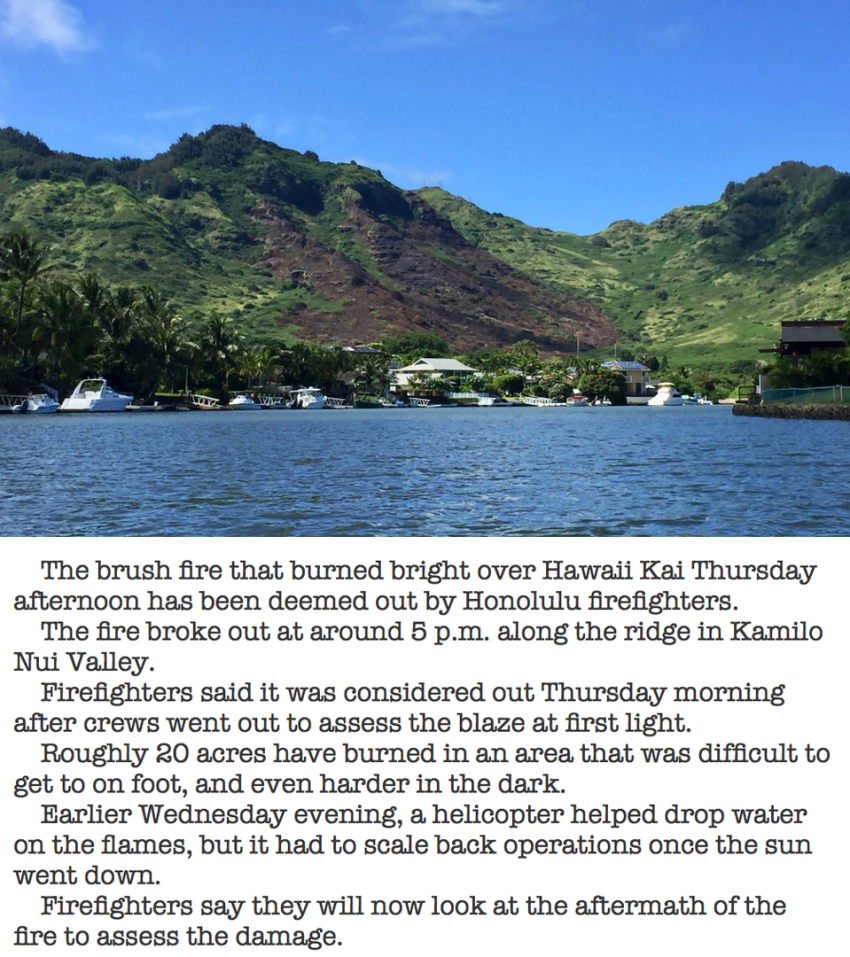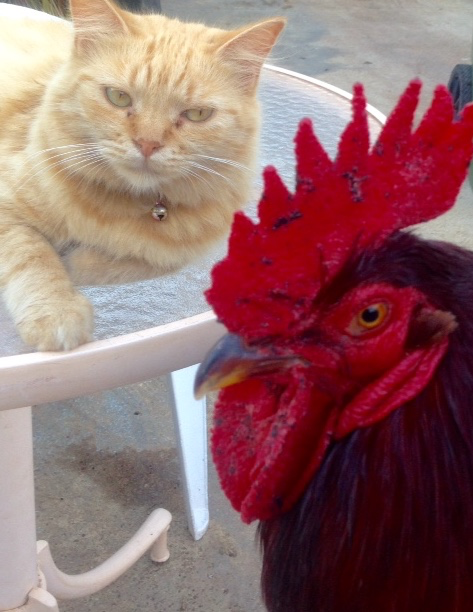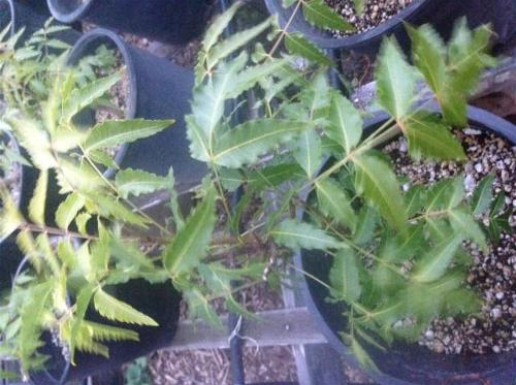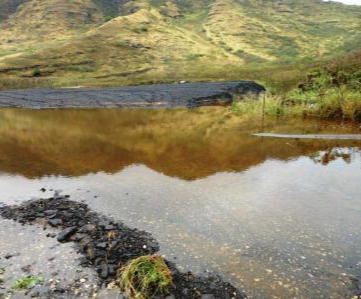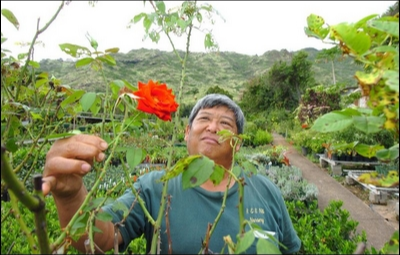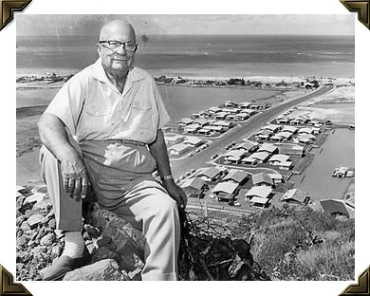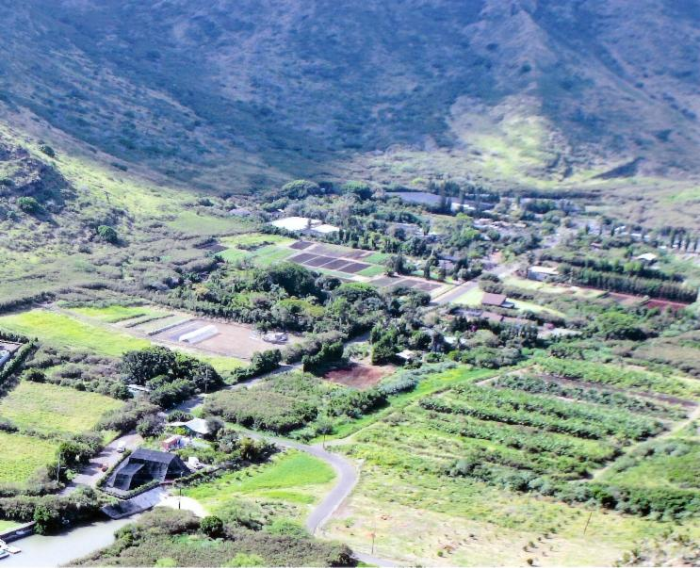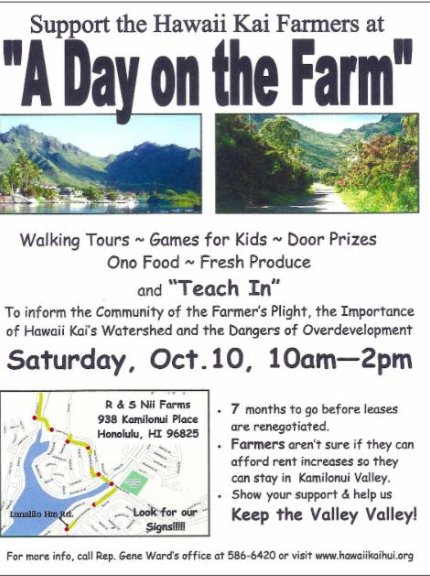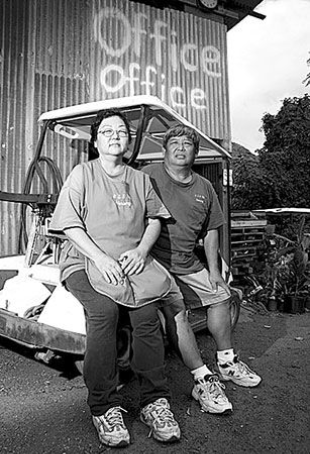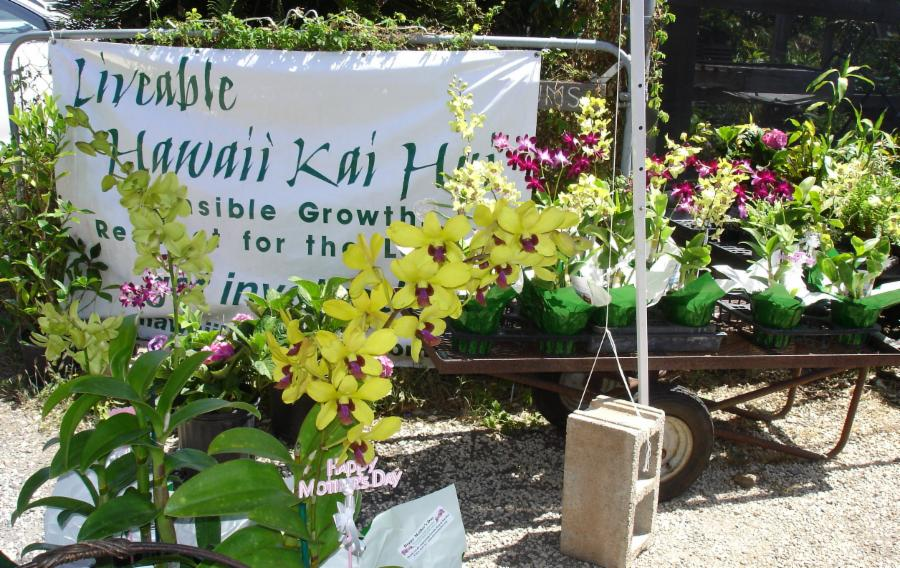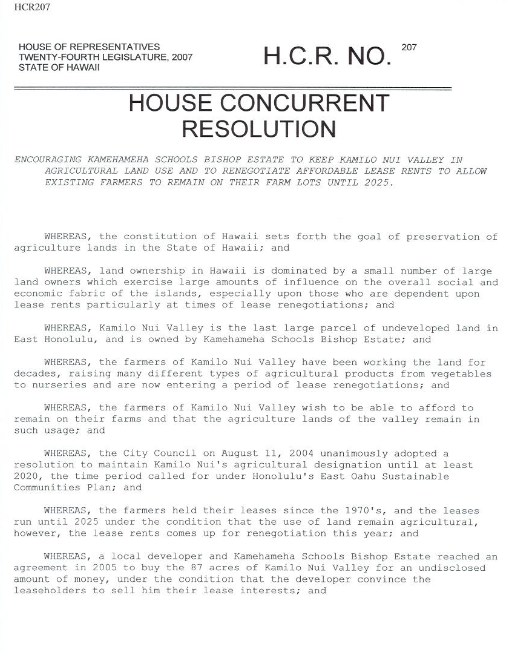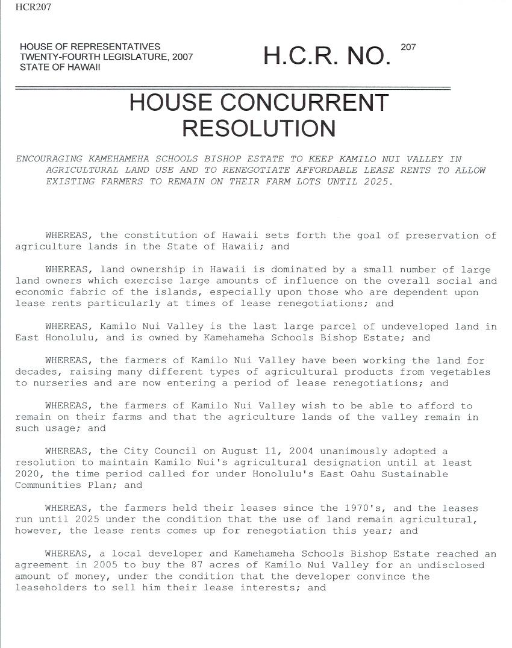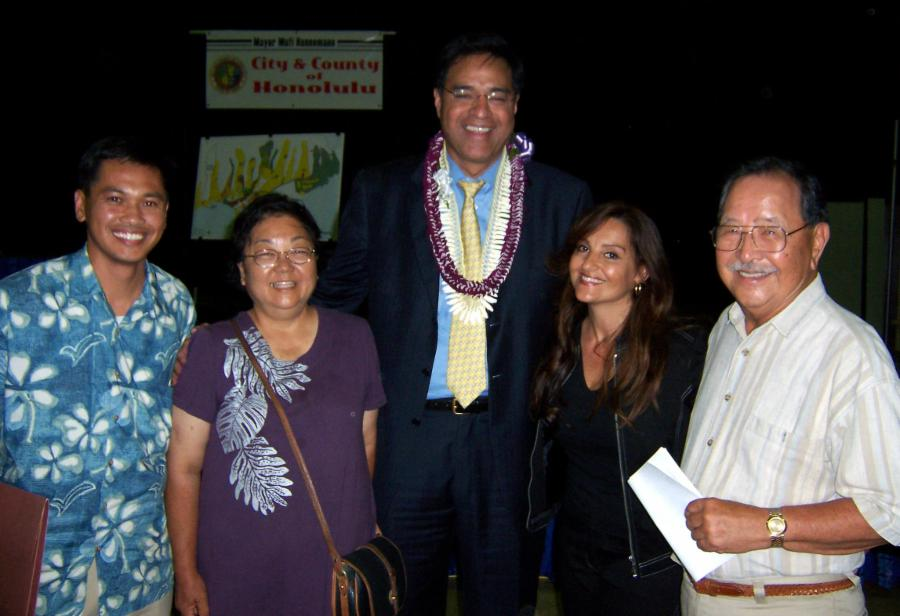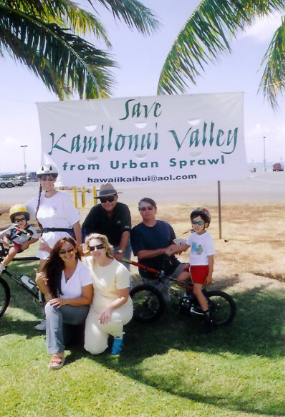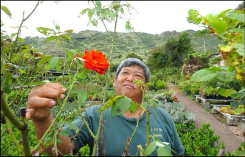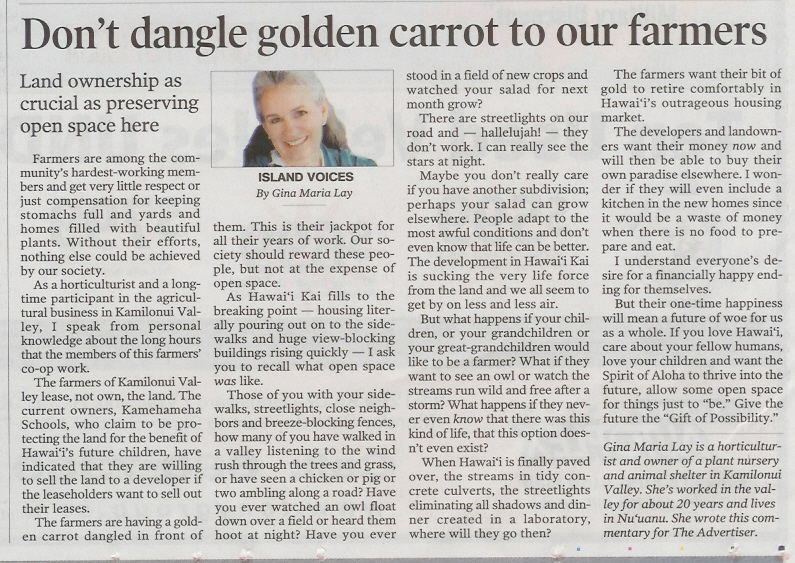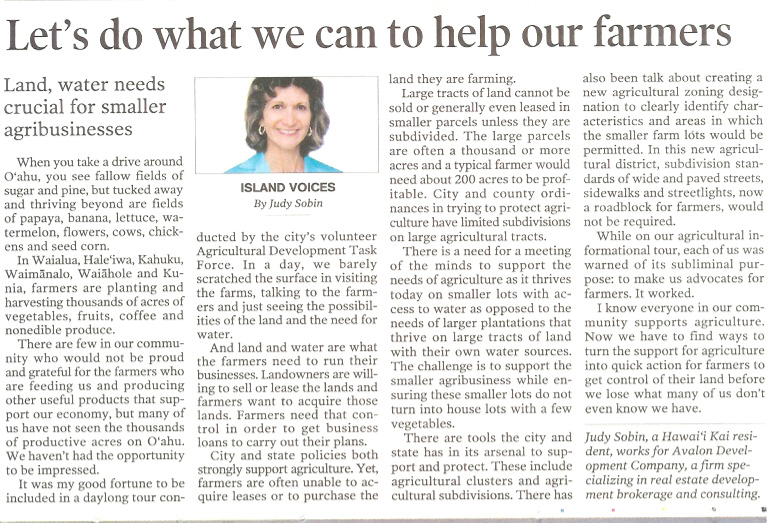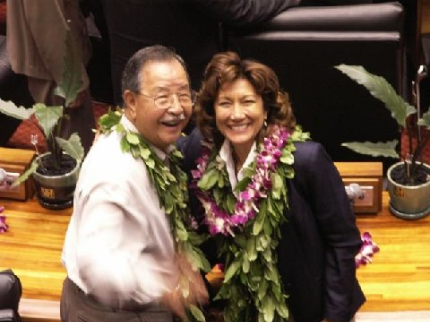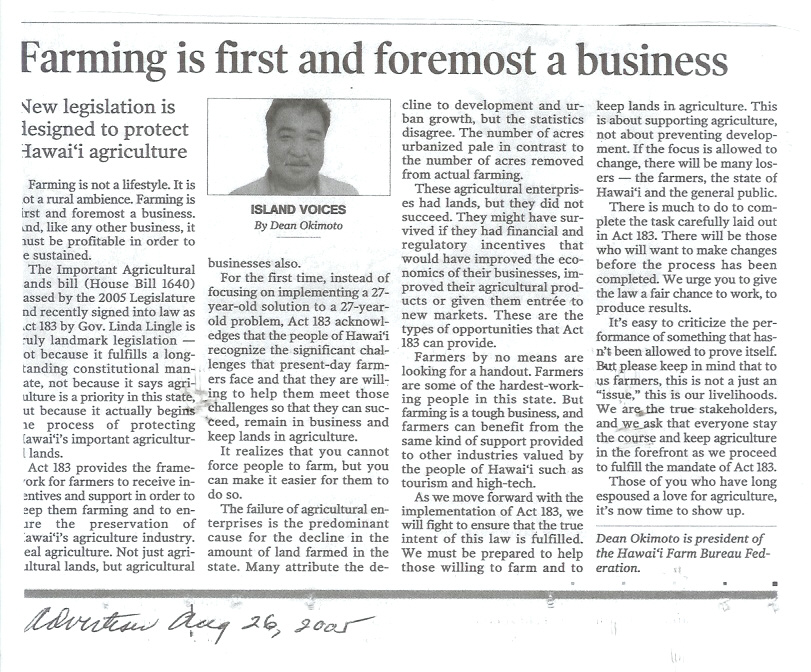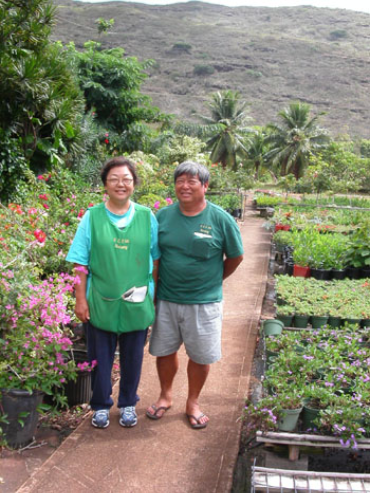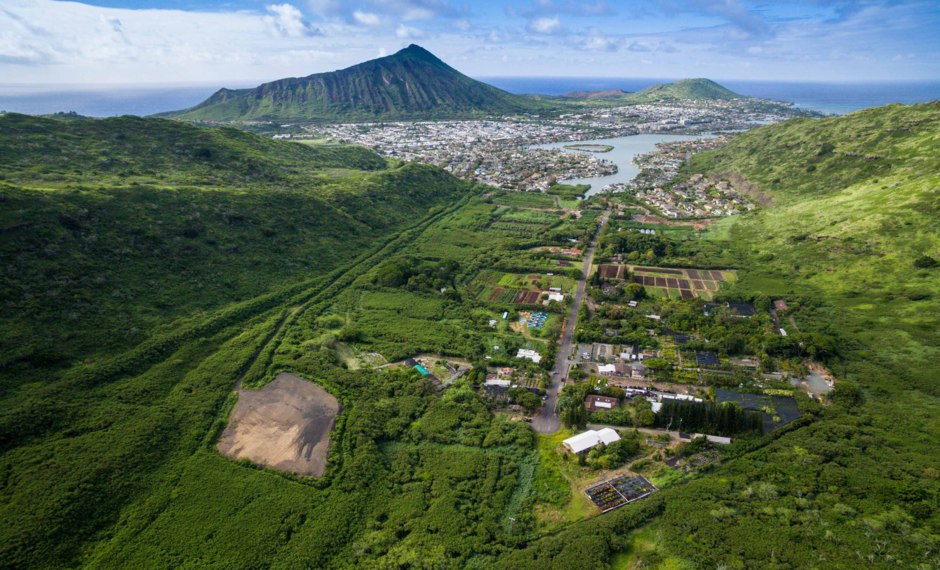
* This page contains most newspaper articles, Letters to the Editors, and on-line publications dating from 2004
Kamilo Nui Valley
2016 - October Volunteer efforts caring for plants at Aloha Aina O Kamilo Nui pay off. Native seedlings are blooming in anticipation of settling their roots in a Maunalua community project. Even the donated "uprooted Ohia Lehua" from an area resident is in bloom. (Mahalo to the Oct. 1st volunteers.)
Neem Plants are available for sale at:
Aloha Aina O Kamilo Nui nursery located at 965 Kamilonui Place, Hawaii Kai.
email: kamilonuivalley@aol.com
To learn about recent developments on neem, please visit the website www.UsingNeem.com and download (free) the 42-page booklet Neem: A hands-on guide to one of the
world's most versatile herbs. Attached is an index I prepared to enable you to see quickly the ailments for which neem has been found effective.
5-31-12 - As part of Maryknoll School's Community Service Day, 135 freshmen students accompanied by their teachers were kindly hosted at Aloha Aina o Kamilonui. The visit was a new and rewarding experience for the students. For many of the freshmen, it was their first time on a working agricultural farm. After learning about Kamilonui's importance as one of the last agricultural areas in East Honolulu, the students teamed up to kokua. By the time the group left several large nursery plots were transformed. The invasive weeds had disappeared and the soil was prepped for planting. To cap the day, the students planted a symbolic hope tree.
Midweek.com - Print Kamilo Nui Farmers: [...]
Adobe Acrobat document [100.1 KB]
3-17-11 - Talks between Kamehameha Schools and farmers continue
QUESTION: Whatever happened to the lease rent negotiations between farmers and landowner Kamehameha Schools in East Oahu’s Kamilo Nui Valley? ANSWER: According to Kamehameha Schools spokeswoman Ann Botticelli, talks are continuing and have not gone into arbitration. Botticelli declined to discuss details of the talks. “That’s not something we’re going to comment on,” she said. Kamilo Nui Valley farmers were initially offered a proposal that would increase their lease from $200 an acre per year to about $5,000 an acre per year, according to the tenants and landlord. Farmer Glenn Nii, representing his family including his father and mother, said a different proposal by Kamehameha Schools is on the table. “We haven’t decided what we’re going to do yet,” he said. Nii declined to discuss the details. Nii said about 10 farmers are negotiating as an alliance with Kamehameha Schools. The lease for new terms as of 2025 came up for negotiation in July. Nii said five of the 10 farm families have members in their 80s and 90s, including his father, Charles. “The older people, all they want to do is live out their life here,” he said. Nii said his father has been leasing land from Kamehameha Schools for more than 60 years. Nii said besides lease rents, farmers face other costs, including insurance and labor. He doesn’t think the 25-fold increase for farmers is reasonable, even though residential rents are considerably higher. “If a quart of milk costs $1 about 40 years ago, does it cost $25 today?” he said. Nii recalled his family moving three times as urban development expanded in East Oahu. Nii said Hawaii people should consider the sustainability of agriculture and what will happen to the cost of food if none is grown locally. “Where is it going to all end?” he said.
11-16-10 Farm Lease Dispute goes to arbitration - Kamehameha Schools called off negotiations with farmers who work 87 acres in Kamilo Nui
http://www.staradvertiser.com/business/20101116_Farm_lease_dispute_goes_to_arbitration.html
The fate of 10 farmers in Hawaii Kai looks like it will be in the hands of three arbitrators after a recent breakdown in negotiations over rent with landowner Kamehameha Schools. The roughly $8 billion private charitable trust recently called off negotiations in favor of arbitration to settle the issue of resetting rents for the last 15 years on the farmers' leases that cover their farms and homes spread over 87 acres in Kamilo Nui Valley. For both sides, the matter is particularly aggravating because many of the farmers are in their 80s and can't farm too actively. But rents haven't changed since they were established in the early 1970s. Kamilo Nui farmers, who lease parcels from three to 10 acres, pay an average $185 an acre per year, which Kamehameha Schools seeks to raise to $5,200 -- a 28-fold increase. Kamehameha Schools believes the farmers should have prepared for the hike knowing that adjusting rents to present market rates would happen this year. The trust, which benefits Hawaiian children and has a fiduciary duty to maximize the revenue from its assets, also emphasizes that it is committed to farming uses of the land for the next 15 years. The farmers, who were relocated to the valley to make way for industrialist Henry J. Kaiser developing Hawaii Kai, say they are willing to pay more but not beyond what they reasonably can afford from farming. Jacking up rents to market rates, they say, would put them out of business. Both sides contend the other is being unreasonable in the matter, which was the subject of a Star-Advertiser story in August after the old rental rates expired July 1. Since then, the group of farmers commissioned a study from an agricultural economist to assess what they could reasonably afford to pay in rent based on what they can produce on their property by themselves or with hired labor. Terry Lee, a Honolulu attorney retained by the farmers to help them negotiate, said Kamehameha Schools rejected the report based on its conclusion, and moved ahead with arbitration. "They said we're too far apart," Lee recalled. "That's the big disconnect." Many of the farmers produce nursery plants. One grows vegetables. The study concluded a reasonable rent would be about $1,000 a year per acre -- about five times more than present rents but one-fifth of what Kamehameha Schools is asking. Judy Nii, who operates R&S Nii Nursery on six acres with her husband, Richard, said Kamehameha Schools is being irrational by demanding "outrageous" rent that no farmer can afford while refusing to look at the merits of the economic analysis. "They have to recognize the validity and importance of the study," she said. The study's author, Sabry Shehata, a professor of agricultural economics at the University of Hawaii at Hilo, is recognized for producing a similar study that helped about 200 Kona Coffee farmers amicably negotiate rents with Kamehameha Schools. Shehata said the coffee farmers represented a larger, more organized and homogenous group, but that he is surprised the trust opted for arbitration without discussing his analysis in negotiations. "It's a shame that they did that," he said. Kamehameha Schools spokeswoman Ann Botticelli said the trust has met with farmers since March, extended deadlines and renewed leases at its proposed rates with two tenants who decided not to be part of the group represented by Lee. "We are headed into arbitration on the lease negotiations, which is the process provided for in the leases if written agreement can't be reached," Botticelli said in a statement. "We believe that the arbitration process will determine a fair price, and we will abide by the arbitrator's decision." Arbitration allows Kamehameha Schools and the farmers group to each pick one appraiser. The two appraisers mutually agree on a third. So far, only Kamehameha Schools has made its selection. The farmers face a deadline to make their selection by tomorrow. Arbitration proceedings could take three or four months. The farmers, who began a sign-waving campaign on Sunday along Kalanianaole Highway, hope their economic study tying rent to farm income will be used to help make the arbitration decision. However, Hawaii commercial property rental rates typically have been settled in arbitration based on a rate of return tied to the value of the land, or by using comparable lease rents. Kamehameha Schools argues that the state recently leased agricultural land in Waimanalo that includes home sites through a competitive bid process for a little more than what the trust is seeking. The trust also said it has negotiated similar rents with several farmers not far from Kamilo Nui Valley behind Kaiser High School. "We still believe our expired offer was fair," Botticelli said.
11-14-10 Farmers fight against Bishop Estate rent hike KHON News Video below.11-14-10 Farmers fight against Bishop Estate rent hike KHON News Video below. 94-year-old Charley Nii has run Charles Nii Nursery for the past 60-years. "Creating all this stuff over here it was a lot of hard work," says Charles Nii. His son Glenn has taken over most of the family's farm of landscape plants, trees and flowers. "We have roughly a little over 6 acres, I'm utilizing about 3 acres right now," says Glenn Nii. For the past 38-years his family and a dozen other farms have been paying a set lease rent to Kamehameha Schools- Bishop Estate of about 15-dollars/acre/month. In July, that old rental rate expired. As part of their rent renegotiation, Kamehameha Schools- Bishop Estate offered they now pay 434-dollars/acre/month. And the right to reside on the the property. "We wouldn't survive if they pushed them up so high," says Charles Nii. "It would be a sad day for him, to see it go. Because he built this thing up," says Glenn Nii. To protest the rent increase Kamilonui Farmers put down their rakes and shovels for picket signs. "We want an affordable rent. Yeah we know the rent needs to be increased and we're willing to pay it but raise it 25-times than what it is now is totally unaffordable," says Judy Nii, R & S Nii Nursery, Inc. Kamehameha Schools- Bishop Estate says "We have been meeting with the farmers since March. We have given them several extensions of time". But they say time is up. Farmers still want to negotiate. "At this point we're just trying to fight for our lives," says Glenn Nii. Kamehameha Schools- Bishop Estate says "we still believe our expired offer was fair". And they are now headed for arbitration to resolve the dispute.
8-18-10 Kamilo Nui could be a cultural resource - Hawaii News - Staradvertiser.com
8-11-10 - Hawaii Kai farmers face
25-fold rent hikeLandowner Kamehameha Schools says rents have not risen for decades; tenants fear they will be put out of business
By Andrew Gomes - http://www.staradvertiser.com/news/20100811_Hawaii_Kai_farmers_face_25-fold_rent_hike.html
11-5-09 - Local Connections: Tannya Joaquin and Hawaii Kai - Kamilonui Valley
http://www.hawaiinewsnow.com/Global/story.asp?S=11453947
HAWAII KAI (HawaiiNewsNow) This growing community is home to 30,000 people, including me. After 50 years of change the last of the old-time farmers are feeling the pinch. A handful of pigs still call Hawaii Kai home. But, it wasn't that long ago when there were more pigs than people. More crops than condos. "You may not know that Kalama valley was pig farms," said author Rich Budnick. "We've got houses there today. There are houses there today, but it was pig farms and in fact, that was the first place Hawaiians fought for land rights." Budnick is author of "Hawaii's Forgotten History." He says the turning point came when developer Henry Kaiser started building. "Hawaii Kai, which means seaward Hawaii, actually Kai is short for Kaiser," said Budnick. "Henry Kaiser being the founder of Hawaii Kai." This is a look above Hawaii Kai today. You'll see all the development, but this all used to be considered unvaluable swamp land. In the 60's, Kaiser began dredging Kuapa Fish Pond, and carving out a community around the marina and Maunalua Bay. Today, they're a main attraction for residents, a favorite spot for families like mine. The first families moved into the neighborhood in 1961. We found that same house. Not much has changed. The only difference? The price. Asking price back then was around $30,000. Today, you'd be lucky to get into this neighborhood for less than $2 million! Kaiser also pioneered the country's first town homes. Terrace Lanais were sold for $19,000. They're still there on Kawaiahae Street, but the area is filled in now with other marina-front properties, even a Costco. Some say Hawaii Kai is too congested now, but it's nowhere near what Kaiser had in mind. "Henry Kaiser wanted to promote Hawaii Kai with resorts, hotels and also a 50,000 seat baseball stadium," Budnick said. Nonetheless, Hawaii Kai has undergone a huge shift from its rural roots. In its hay day, 60 percent of Oahu's lettuce, pigs and flowers were grown here. Farms were everywhere, including where Kaiser High is today. My husband Alan, a '92 graduate witnessed new complexes sprout up across from campus. "The developments that took place of all the bare land that sat there for all those years.All these homes and townhouses started popping up," Alan Joaquin said. As developers built up and out, farmers got pushed farther and farther inland. "We were pushed back into this valley here," said Kamilonui farmer Glenn Nii. "It was funny because everyday the road to get back into the valley would change because there's a house in our way. So okay, we have to go around the house to get back into the valley. Major change back here." Many residents don't realize Hawaii Kai has 87 acres of farmland, right in their own backyard. "(It's) the last stronghold for East Oahu," Nii said. Last month, Kamilonui farmers organized this "Keep the Valley, Valley" day to let neighbors know they're here and want to stay. "Keep the land ag is the main thing. We need sustainability in East Oahu," Nii said. The Nii family has had nurseries since the 50's when the area was known as Koko Head. But, the family tradition will likely end with his generation. "My kids don't want to do it. They see the writing on the wall," Nii said. All the leases are up for renegotiation next year, and end in 2025. The few farmers left fear rising real estate values will force them out and alter Hawaii Kai's landscape for good.
Looking Back - Community support at Hawaii Kai Neighborhood Board - Minutes 2004 - http://www.co.honolulu.hi.us/refs/nco/nb1/04/1julmin.htm
It was over 5 years ago when Hawaii Kai residents filled the Hahaione School Cafeteria wearing green ribbons tied to their fingers. Hawaii Kai Neighborhood Board No. 1 supported City Council Resolution 04-198 – Reiterating support for the 1999 East Honolulu Sustainable Communities Plan including preserving agricultural lands on Kamilonui Valley. In 2010 the farmer's lease rent will be re-negotiated.
To some, Kamilo Nui Valley is irreplaceable open space and referred to as our little bit of country. To others, Kamilo Nui Valley is a natural watershed with unknown capabilities that should be explored and managed. Yet to others, Kamilo Nui Valley is a place to celebrate, teach and learn Hawaiian traditional practices of caring for the land, Mauka to Makai. And to all, Kamilo Nui Valley and the farm lots above Kaiser High School are the last remaining agriculture lands on the East end of Oahu and should be protected, in perpetuity, for the future generations.

Adobe Acrobat document [123.0 KB]
City Council Resolution 04-198 – Reiterating support for the 1999 East Honolulu Sustainable Communities Plan including preserving agricultural lands on Kamilonui Valley. In 2010 the farmer's lease rent will be re-negotiated. Please show your support for the Farmer's by coming out to our Farm Day Event. There will be food, fun for the kids, and information on how vital this area is for the future generations of Hawaii Kai & East Oahu


10-10-09 - Opens at 10:00 a.m. with the blessed New Hope Hawaii Kai band performing “God Bless America”, followed immediately by:Plant Sale and Farmers Market - 10 to 11 a.m.
Special Appearance: by music award winning band
Bounce House and Kid Games - throughout day !!!
Teach-In's - Guest Speakers
Community Organizations – Informational Booths
Guided Walking Tours
Kau kau available all day
Questions? Comments?
Please contact Pam Kam, Community Liaison to Representative Gene Ward
@ 358-9145. See you on Saturday, October 10, 2009 !
Click here to see a SLIDESHOW OF FARM DAY
10-4-09 - Honolulu Weekly - http://honoluluweekly.com/hotpicks/2009/10/farmers-delight/
FARMER'S DELIGHT - BY MITCHELL KUGA
In 2007, bumper stickers began appearing in east Oahu, stating “Keep the Valley Valley.” The “Valley” being referenced was Kamilonui Valley, the last remnant of
agricultural activity in Hawaii Kai, and the bumper stickers, devised by Hawaii State Representative Gene Ward and his team, were a small way to spread a big message about the concrete
infrastructures swamping an area once known for its lush greenery. In the words of Hawaii Kai Rep. Gene Ward, it’s become “overdeveloped.”
Things could get worse. In seven months, lease negotiations with Kamehameha Schools could very well result in a steep increase in rent prices in Kamilonui Valley, forcing what’s left of east Oahu’s
farming industry out of business. Such a move, according to Ward, would pose “a clear and present danger to all of us who live in this community.”
This Saturday, learn about some of these dangers while having some serious fun at “A Day on the Farm,” an open house being held at R&S Nii Farms, which specializes in traditional Hawaiian farming
methods. The event, sponsored by Ward and the Kamilonui Farmers’ Co-op, will feature games for kids, live entertainment, onolicous super fresh foods, door prizes, community booths and farm tours.
However, the main objective is getting the community face to face with Kamilonui farmers–who Ward calls “one of the best kept secrets on this island”–in an attempt to educate residents about farm
life, the importance of sustainable living and the plight facing modern day farmers.
“We say we want food sustainability yet we’re willing to eliminate the people who are going to get us there,” Ward said. “The event is a great chance for community members to get their hands dirty in
600 acres of farmland, to see what the farmers look like and what they do.”R&S Nii Farms, 938 Kamilonui Place, Sat 10/10, 10am-2pm, free, [hawaiikaihui.org], 586-6420
OCTOBER 4th. 2009 -
Celebrating Kamilo Nui Valley - our little bit of country
Elizabeth Reilly
Reader Submitted
Celebrating Kamilo Nui Valley our little bit of country
Community groups Livable Hawaii Kai Hui and Aloha 'Aina 'O Kamilo Nui were equally pleased to be invited to participate in the first annual "Day on the Farm" sponsored by the Kamilo Nui Farmers
Cooperative and supported by Representative Gene Ward and staff.
Jeannine Johnson of Aloha 'Aina 'O Kamilo Nui said " we are looking forward to introducing the mission and vision of our newly formed non-profit to the community and hope to turn new friends into
'aina volunteers or kokua sponsors". Johnson also noted she is "delighted to spend the day in the country."
Tai Hong of Livable Hawaii Kai Hui said "a Day on the Farm is a dream come true" as his organization was originally formed over 5-years ago to help protect the valley from development, maintain the
open-space, promote the valley's agriculture component and natural watershed qualities.
The event will be headquartered at R&S Nii Nursery (Richard & Judy Nii) and kicks off with a blessing a 10AM in the morning and followed by fun and games, drawings, and a "Teach In" about the
history and importance of keeping our farmers in Hawaii Kai. A children's' bouncing house and ono food vendors will also be onsite.
So when was the last time you walked the country road of Kamilo Nui Valley? When did you last support your local plant nursery? Do you know the value of having agriculture land right here in Hawaii
Kai to serve East Honolulu needs? Please join us, the farmers and everyone else on Sunday, October 10th starting at 10 AM for a "Day on the Farm" to learn about the valley, the farmers, and make new
friends. Additional community organizations participating include: Hawaii Kai Neighborhood Board, Malama Maunalua, Manalua.net, Kaiser High School Interact Group Rotary, Maunalua Fishpond &
Heritage Center and 'Aina in the Schools. To learn more about Kamilo Nui Valley go to: www.hawaiikaihui.org
10-31-08 KAMEHAMEHA SCHOOLS PROMISES TO HONOR KAMILO NUI VALLEY FARMERS LEASES TO KEEP LAND IN AG, AS 2010 APPROACHES: click on link for the
video: www.kitv.com/video/17854272/index.html
5-11-08 - Mothers Day Plant Sale - Our First Fundraiser in the Valley
A big Mahalo to all that supported our 1st LHKH fundraiser! It was great to get people back into the Kamilo Nui Valley. It was so amazing to hear how many folks had never seen the farm lots and were totally impressed that they could travel just around the corner and find themselves in a country setting. Remember, don't overwater the orchids!
HRC - 207
 6-12-06 June 12th, 2006 at Kaiser High
School. - Honorable Mayor Mufi Hannemann is surrounded by Kamilo Nui Valley Farmers Judy Nii (Left), and Thomas Yamabe (Right). AJ Halagao (left), and Elizabeth Reilly (right), is founder and spokeperson for
Livable Hawaii Kai Hui. This photo was taken at the Mayors Town Meeting.
6-12-06 June 12th, 2006 at Kaiser High
School. - Honorable Mayor Mufi Hannemann is surrounded by Kamilo Nui Valley Farmers Judy Nii (Left), and Thomas Yamabe (Right). AJ Halagao (left), and Elizabeth Reilly (right), is founder and spokeperson for
Livable Hawaii Kai Hui. This photo was taken at the Mayors Town Meeting.
5-15-06 Posted on: Monday, May 15, 2006
Letters to the Editor
URBAN SPRAWL
CHARTER PANEL IGNORED 'VOICE OF THE PEOPLE'
Is the City Charter the voice of the people? In your May 10 editorial "Some planned charter changes miss the mark" you wrote, "Honolulu's citizens have a strong environmental and conservation ethic,
and it is proper to recognize this philosophy to some degree in the City Charter."
You know this, we know this but apparently the Charter Commission does not.
In fact, they (excluding three enlightened commissioners) completely missed the mark at the May 10, eight-hour-long meeting where they passed only one of 10 planning, zoning and environmental
proposals.
This means the people of Honolulu will not have the chance at the November elections to vote on measures designed to protect us from urban sprawl.
We reminded the Charter Commission that this is an island environment with finite land. And we testified as to the challenges we face in East Honolulu regarding protecting our urban growth boundary
from shifting prematurely to accommodate a housing development in Kamilo Nui Valley and another on Paiko Ridge.
Despite these facts, not a single, vital urban growth boundary proposal passed! So we ask, is the charter the voice of the people?
Tai Hong
Hawai'i Kai
Elizabeth Reilly
Hawai'i Kai
HONOLULU
3/13/06 - Hawaii Reporter Freedom to Report Real News
City Should Not Break Its Promise and Change Agriculture Boundaries
By Bob Hampton, 4/15/2004 8:28:47 AM
According to the city's "Vision Statement" publicly recorded in 1995, paragraph 2.2.1: "The Vision For East Honolulu's Future, These are the Urban Community Boundary, the
Agriculture and the Preservation Boundary. It is intended these boundaries will remain fixed through the 2020 planning horizon." With this vision statement, the city committed to its citizens a good
and sound planning statement that we in East Oahu can use to guide our future.
Councilman Charles Djou says "the community could use a break from the sound of hammers and drills." The community also needs time to assimilate the 800 plus new homes that have sprung up in the last
two years. Most are not even occupied and it will take some time to get these families settled into our community. Standford Carr is on a development roll and wants to push forward with another 200
homes, this time using the city promised agricultural valley lands. Carr should stop for a moment and think about the 800 new families that he brought in to Hawaii Kai. Carr should be concerned about
letting them settle in and making sure his promises and representations to them are met. Here is where our city councilman can help the most.
For the city to break the promise it made to the community in the Vision Statement and change the Agriculture Boundaries in Kamilonui Valley to Urban is simply wrong and
its is very poor community planning.
It is obvious the Hawaii Kai community does not like developer Carr's massing of homes on the Peninsula but most folks understand that the property he developed was
already site planned before him and zoned in that manner by Kaiser. Not so in Kamilonui Valley. The committed plan there is Agriculture until the year 2020.
If some of the farmers wish to sell out to a developer, any developer, that is alright. But the developer should know that until 2020, they have bought a farm and farming
is what the developer needs to do. By 2020, all of the home building in the period 2000 to 2005 will have settled in and the community may be ready for a new 200 families, maybe.
Bob Hampton is a resident of Hawaii Kai.
HawaiiReporter.com reports the real news, and prints all editorials submitted, even if they do not represent the viewpoint of the editors, as long as they are written clearly. Send editorials
to mailto:Malia@HawaiiReporter.com
3-1-06 SAVING EAST OAHU'S KAMILO NUI VALLEY FROM DEVELOPMENT
Hawaii Kai has almost reached full capacity.
We would like to see a few wide open spaces left for the future children of East Oahu.
Hawaii Reporter
Freedom to Report Real News - By Marian Grey,
2/1/2006 11:46:20 AM
Last Thursday evening, the Hahaione Elementary School’s cafeteria was filled by community members concerned about losing the last large open area in Hawaii Kai, land
currently zoned "agricultural" by the City and County of Honolulu, and "urban" by the State.
Currently a written agreement between Kamehameha Schools, the landowner and Stanford Carr a developer exists which would turn the 87 acres of agricultural land into a large housing development.
The valley’s farmers face individual "lease renegotiations" between 2007 and 2010 with Kamehameha Schools who control’s the farmers’ future and whether or not they will be able to continue operations
until their leases expire, sometime between 2020 and 2025.
The farmers, and the community are afraid that if Kamehameha Schools want to sell their property to Stanford Carr for a Housing Development, those rents will be so overpriced, that the farmers will
have no choice, but to vacate their land.
The community members, and several elected officials have expressed that they will support the farmers, and spare no efforts in "Keeping Kamilonui Valley Green". Any effort by developers and
Kamehameha Schools to change the zoning to residential will be fought vigorously.<< New image with text >>
Marian Grey is a resident of Hawaii Kai and a researcher at the Hawaii State Capitol in the office of Sen. Sam Slom
<
1-23-06 KAMILONUI FARMERS HOPE TO STAVE OFF DEVELOPMENT
Posted on: Monday, January 23, 2006
Kamilo Nui farmers hope to stave off development
By Suzanne Roig
Advertiser East Honolulu Writer
- Richard Nii runs a nursery in Kamilo Nui Valley and is worried about development coming to the last agricultural valley in the Hawai'i Kai area. Stanford Carr Development has entered into a deal with landowner Kamehameha Schools to purchase and develop the 87 acres.
- DEBORAH BOOKER | The Honolulu Advertiser COMMUNITY MEETING
- Residents who want land in Kamilo Nui Valley to continue to be used for farming, and those who want it to be sold to a developer, can attend a community meeting at 6 p.m. Thursday at the Haha'ione Elementary cafeteria.
- HAWAI'I KAI — Rows of vivid red and pink poinsettias fill the entrance to Dean Takebayashi's farm in Kamilo Nui Valley.
- Likewise, up the street rows of blossoming roses of all colors greet visitors at R&S Nii Nursery, roosters and chickens roam freely, pecking at the dirt.
- This piece of country living is wedged in the back of suburbia and has been here for decades. Every day, customers ask if the farmers will be here next year.
- Takebayashi and the Nii family don't know how to answer that.
- They'd like to continue farming in the quiet valley in Hawai'i Kai as they have for the past 40 years or so, but their landowner, Kamehameha Schools, wants to sell the land.
- There's no value in holding on to the land in agriculture, particularly since the 14 farmers are paying slightly more than $200 a year per acre in lease rent, the landowner has said. Their leases expire in 19 years.
- Because Kamehameha Schools has entered into an agreement with local developer Stanford Carr Development, which has agreed to purchase the 87 acres and develop it, Kamehameha Schools is left waiting for Carr to make a move.
- This is the last chunk of land that, until recently, residents thought would remain in agriculture and not be turned into homes.
- Residents who want to see the land remain for farming have organized a meeting with the landowner, the community and the farmers for the second time in six months to discuss its plans for the land.
- That meeting is scheduled for 6 p.m. Thursday at the Haha'ione Elementary School cafeteria.
- In September, more than 100 people showed up at the community meeting to voice concerns.
- Land use has become a murky issue, as half of the 14 farmers would like to stay and farm and the other half want to retire. The problem is that many of their leases begin renegotiating as early as next year, and banks do not like to make loans to prospective buyers with such unknowns as what the lease rent might be or whether the owner will demand the land back.
- And without an agreement from the landowner to write a new lease, farmers don't know where to turn.
- "If I stay," Takebayashi said, "I want to renegotiate the lease rent for something that is economically feasible. I'd like to stay and continue my business if the lease rent is reasonable. I can't do my business if it's not.
- "It's not easy being a farmer."
- Kamehameha Schools has said that it won't negotiate with individual owners, but only the Kamilonui Valley Farmers Cooperative, an organization formed when the farmers first moved to the valley as a way to fund road, sewer and water improvements more than three decades ago.
- "There is nothing new from Kamehameha Schools perspective," said Kekoa Paulsen, the landowners' spokesman. "The proposal (from Stanford Carr) is still out there. Stanford Carr is the one to make the deal happen."
- Residents say the valley plays a vital role in preserving Hawai'i Kai's ecosystem. It is a watershed, a green belt. Mostly, it's the last valley in Hawai'i Kai to remain free of homes.
- "Once it's gone, it's gone forever," said Tai Hong, a member of the Livable Hawai'i Kai Hui, a group formed to preserve open space in the community. "The land is very valuable now, but we want to strike a balance between preservation and development."
- The land lies outside the city's designated area for development. Being outside the urban growth boundary and being designated as agriculture land, should offer protection, but rezoning has happened before on farm land in Hawai'i Kai. More than 1,000 new homes have been added to the community during this recent spate of development and is not reflected in current census figures that show there are 27,657 people. That's a 0.8 percent increase from 1990 to 2000.
- City Councilman Charles Djou, who will be at Thursday's meeting, said that he believes the land should remain agricultural and not be developed. And while the community of farmers and residents have been discussing the future of the valley as if a proposal is before the city for a housing development, no plans have been submitted to the city for review, Djou said.
- The process, should plans come forward, would take at least two years from re-zoning to the start of construction, he said.
- "Kamilo Nui's future rests with the City Council," Djou said. "The zoning code is the law of the land and the law of the land says this parcel is designated as agriculture."
- Those trying to keep the valley undeveloped and in agriculture believe they have to remain vigilant, despite Djou's promise of many public hearings. It happened before where a piece of agriculture land was carved out to make room for 65 homes built by Schuler Homes. That was nearly four years ago.
- Richard Nii, who has spent his whole life farming, sees the area differently.
- He sees it as home, the place where he was raised and where he has raised his children.
- He has been in Kamilo Nui Valley since his dad's farm was moved from Mariner's Cove in the late 1960s to make room for a housing development. That was the family's second move because of a shift in land use.
- "I've always known it would come to something like this," Nii said. "We want to continue farming. Many of our customers ask us if we're going to move or stay."
- Reach Suzanne Roig at sroig@honoluluadvertiser.com.
12-3-05 - posted in the Honolulu News
Adobe Acrobat document [1.5 MB]
11-29-05 - by Gayle Carr
Adobe Acrobat document [66.8 KB]
11-27-05 THE FUTURE OF KAMILO NUI VALLEY - by Kevin O'Leary http://honoluluweekly.com/cover/2005/11/the-future-of-kamilo-nui/
10-27-05 Posted on: Thursday, October 27, 2005
Letters to the Editor - By Gayle Carr
PROTECT WATERSHED - LET'S GIVE BACK TO KUAPA POND
In 1961, Bishop Estate leased a 6,000-acre area, which included Kuapa Pond, to petitioner Kaiser Aetna for subdivision development now known as Hawai'i Kai. Once an integral part of the Hawaiian
feudal system, fishponds were allotted as parts of large land units, known as ahupua'a, by King Kamehameha III. Kuapa Pond was part of an ahupua'a that eventually was vested in Bernice Pauahi
Bishop.
Dredging and filling operations converted Kuapa Pond into a marina. The Pacific tides ebbed and flowed over
the pond in its pre-marina state. The tide entered through two openings in the barrier beach; it also percolated through the barrier beach itself. Although large areas of land at the inland end were
completely exposed at low tide, the entire pond was inundated at high tide, and rainwaters flowed down from the mountainsides that surrounded the pond. A water body such as Kuapa Pond is contiguous
to Maunalua Bay and should be regarded as an arm of the sea. Kuapa Pond originally was created by natural forces. Encompassing the pond were luscious mountainsides where natural waters
flowed.
The destruction of an oyster bed in Maunalua Bay and the vanishing of the Hawaiian stilt resulted from dredging a channel and creating a beautiful place for us to live.
The public right of navigation is the dominant right, and the right to live on this present-day pond is truly exceptional.
Kuapa Pond has sacrificed so much that maybe it is time we gave something back. In 1996, the Hawaiian stilt finally returned to Kuapa Pond. The necessary precautions are now being taken to protect
this endangered species so it may propagate.
Now is a crucial time for us to protect the natural watershed that is Kamilonui Valley. Coastal environments are strongly influenced by upstream sources and freshwater
inflow. Keeping a natural watershed to feed the pond will promote a healthier bay and aid in its effort to get back to the way it once was in earlier days. Keep Kamilo Nui Valley properly designated,
outside the Urban Growth Boundary, while letting nature take its course.
Gayle G. Carr
Hawai'i Kai Marina
10-25-05 - October 25, 2005 the neighborhood board re-instated their support for Resolution 04-198....They agreed unanimously that Hawaii Kai should keep the Urban Growth Boundary intact and not shift it to accommodate more development. Please refer to our Hawaii Kai Neighborhood Board page(link) to read the minutes for the October 25th meeting.. Last year on July 27, 2004 the Honolulu City Council Planning Committee voted to support Resolution 04-198. The Hawaii Kai Neighborhood board also voted to support it. The vote was unanimous.(The 2004 article is below - scroll down.)
Hawai'i Kai cemetery plans advancing slo[...]
Adobe Acrobat document [176.0 KB]
9-28-05 City Must Guard Use of Kamilonui Land
Posted on: Wednesday,
September 28, 2005
City must guard use of Kamilonui land
On an island as small as O'ahu, land naturally becomes a prized asset. The goal of maintaining open space must not be tossed aside thoughtlessly, especially in a community as beset by urban sprawl as
Hawai'i Kai.
City leaders have a rare opportunity to show commitment to that goal in Kamilonui Valley.
Seventeen farmers in the valley are considering whether to get out of their farm leases from Kamehameha Schools. Regardless of whether they can agree, the landlord says other farmers aren't
interested in taking over once the leases lapse in 17 years.
Kamehameha may have found a buyer in Stanford Carr Development, which wants to convert the 87 acres into house lots. Even if the few holdout farmers decide to sell, building homes requires the city
to change the allowed land use from agricultural to urban.
That means city planners and council members will ultimately decide how it will be used. Certainly allowing every available piece of land to be used for housing makes no sense. A healthy community
requires the right balance.
This parcel was set aside for farming in the East Honolulu Sustainable Communities Plan. It seems pointless to devise a blueprint for livable neighborhoods if it can be abandoned without careful
thought.
The city must make it clear to the developer at meetings planned for coming weeks that this project would reverse the community's stated vision for the area. There's considerable concern among
residents about how the additional homes would affect them, including worries about traffic on the crowded Kalaniana'ole Highway. And rightly so.
Surely these issues will be raised at scheduled public hearings. And politicians should listen intently.
Strong leadership at the grassroots level and from elected officials is needed. Finding the best use of the land must remain the focus, precisely because it's so precious

9-22-05 Trust Likely to Sell Farms - http://the.honoluluadvertiser.com/article/2005/Sep/22/ln/FP509220322.html
Trust likely to sell farms | The Honolul[...]
Adobe Acrobat document [122.0 KB]
9-22-05 HAWAII REPORTER - Freedom to Report Real News
Keep Hawaii
Kai Green
Farms Should Be Saved By Thomas Yamabe II,
9/22/2005 8:55:16 PM I would like to thank the panel speakers, farmers and community members for attending the Kamilonui Valley meeting on
Sept. 20, sponsored by Livable Hawaii Kai Hui. I was very much impressed with the community turnout and the concerns they expressed. I am in complete agreement with the East Honolulu Sustainable
Communities Plan, which maintains Kamilonui Valley outside the urban growth boundary. Furthermore, this plan supports Mr. Henry J. Kaiser's commitment to maintain Kamilonui Valley as open space in
perpetuity and keep it in agriculture as supporting use at no cost to the City. I want to inform the public that I and other farmers who share the same purpose with Livable Hawaii Kai Hui, will
continually stay in contact to help dispel some of the erroneous information that has intentionally or otherwise, been written. For example, I am one of the older farmers in the valley who believes
in a well-planned community over short term economic gain. I agree with how the community supports keeping the valley in for open space in perpetuity. In an article dated Sept. 22, it states that
Kamehameha Schools issued a lease agreement to the farmers co-op but this is incorrect -- I know of no lease agreement with the farmer's co-op but I do know there are individual lease agreements
between each farmer and Kamehameha Schools through 2027. Approximately 30-years ago, the development of this open area was understood by all parties involved, that Kamilonui Valley is part of a
permanent plan for Hawaii Kai as are schools, parks, beach access and marina, which through use, provides a service to the community. It should not be the immediate current value of land but rather
the value the valley holds for the children and grandchildren of tomorrow. I sincerely believe that recognition of a well-balanced community plan will bring socio-economic benefits to all members of
the community. Thomas Yamabe II is a Kamilonui Valley lessee.
HawaiiReporter.com reports the real news, and prints all editorials submitted, even if they
do not represent the viewpoint of the editors, as long as they are written clearly. Send editorials to mailto:Malia@HawaiiReporter.com .
9-19-05
Developer Gains Negotiation Rights for Kamilonui Farmlots
http://starbulletin.com/2005/09/19/news/story5.html
9-19-05 Kamilonui Farmers would yeild to houses in proposal
http://the.honoluluadvertiser.com/article/2005/Sep/19/ln/FP509190335.html
8-25-05 FARMING IS FIRST AND FOREMOST A BUSINESS
Posted on: Sunday, August 1, 2004 -
HONOLULU ADVERTISER
Farmland decision cheered
By Suzanne Roig Advertiser East Honolulu Writer HAWAI'I KAI — Wearing green ribbons tied to their thumbs, about 50 residents filled the
Haha'ione Elementary School cafeteria to show their support for keeping Kamilonui Valley in farmland. They cheered when the Hawai'i Kai Neighborhood Board voted Tuesday night to support a City
Council resolution backing the East Honolulu Sustainable Communities Plan, a blueprint for building in the community that designates the land as agricultural.
The measure had been heard earlier that day at the City Council Planning Committee, which made approval dependent on the community's
vote. The resolution now moves to a full council vote Aug. 11 as part of a periodic city review of the plan. Elizabeth Reilly, who has led a grass-roots community effort to keep the valley in
farmland, turned in a petition with more than 1,500 signatures to the council and the neighborhood board. Kamilonui Valley, home to about 15 farmers of vegetables and nursery plants, has become a
battleground between residents who want the leased land to continue as farms and a developer who has offered to buy the farmers out so he can build 200 new homes. "Kamilonui Valley is the last
remaining agriculture land on the east end of O'ahu," Reilly said Tuesday night. "When it is gone, it is forever. It is part of the authentic character of our community. It is one of our
distinguishing features, as is Koko Crater, our private marina and easy-access shoreline." In the past five years, Hawai'i Kai has seen the construction of about 1,000 new homes, townhomes and
apartments, and residents have urged lawmakers and the community to support keeping the valley in agriculture. Stanford Carr, who proposes to build in Kamilonui Valley, could not be reached for
comment. However, Mike Jones, president of Schuler Homes Hawai'i, said new development has a place in any community. With four housing projects in Hawai'i Kai recently completed or being built,
Schuler Homes has heard its share of complaints from residents about traffic, Jones said. But in the long run, new housing developments provide a steady customer base for existing businesses and
attract new businesses to a community, he said. "The more people, the more businesses are attracted to the area, and it keeps the businesses that are there healthy by ensuring that they have a strong customer base," Jones said. The community's building plan is up for city review in a process done every five years. The city sets up
meetings with key community members and will hold public meetings in the fall, said Manny Menendez, who represents the city at neighborhood board meetings and is a member of the Hawai'i Kai
Neighborhood Board. Menendez suggested that the community consider establishing a land trust for the 84 acres in Kamilonui Valley so the farmers — many of whom are in their 70s — can be compensated
and the community can keep the land free from development. "We owe it to ourselves to keep the land in open space," he said.
Reach Suzanne Roig at sroig@honoluluadvertiser.com or 395-8831.
7-27-04 the Honolulu City Council Planning Committee voted to support RESOLUTION 04-198 (See PDF below),The Hawaii Kai Neighborhood board also voted to support it. The vote was unanimous.
Adobe Acrobat document [123.0 KB]
THE NII FARM
